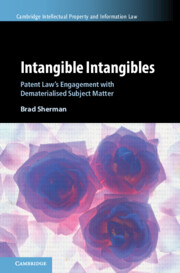
-
Select format
-
- Publisher:
- Cambridge University Press
- Publication date:
- April 2024
- May 2024
- ISBN:
- 9781009479639
- 9781009479615
- 9781009479608
- Creative Commons:
-
This content is Open Access and distributed under the terms of the Creative Commons Attribution licence CC-BY-NC 4.0.
https://creativecommons.org/creativelicenses - Dimensions:
- (229 x 152 mm)
- Weight & Pages:
- 0.59kg, 304 Pages
- Dimensions:
- (229 x 152 mm)
- Weight & Pages:
- 0.45kg, 304 Pages
Open AccessYou have access to this book- Series:
- Cambridge Intellectual Property and Information Law (63)
Book description
This book takes as its starting point recent debates over the dematerialisation of subject matter which have arisen because of changes in information technology, molecular biology, and related fields that produced a subject matter with no obvious material form or trace. Arguing against the idea that dematerialisation is a uniquely twenty-first century problem, this book looks at three situations where US patent law has already dealt with a dematerialised subject matter: nineteenth century chemical inventions, computer-related inventions in the 1970s, and biological subject matter across the twentieth century. In looking at what we can learn from these historical accounts about how the law responded to a dematerialised subject matter and the role that science and technology played in that process, this book provides a history of patentable subject matter in the United States. This title is available as Open Access on Cambridge Core.
Reviews
‘The book is a significant contribution to IP scholarship, offering a comprehensive and thought-provoking examination of how patent law has evolved. Sherman’s analysis enriches the reader’s understanding of contemporary legal challenges and provides a robust framework for future research.’
Pratap Devarapalli Source: Journal of Intellectual Property Law & Practice
‘A fascinating and thoughtful book that traces knowledge exchanges between science and technology and intellectual property that enabled US patent law to accommodate the new fields of invention that have transformed global industries, economies and societies.’
Kathy Bowrey Source: Journal of The Intellectual Property Society of Australia and New Zealand
‘… so rich and subtle that it can only inspire deep reflection.’
Gabriel Galvez-Behar Source: 2024 ISHTIP 15TH Annual Workshop
Contents
Full book PDF-
Intangible Intangibles
pp i-i -
-
- You have access
- Open access
- HTML
- Export citation
-
-
Cambridge Intellectual Property and Information Law - Series page
pp ii-ii -
-
- You have access
- Open access
- HTML
- Export citation
-
-
Intangible Intangibles - Title page
pp iii-iii - Patent Law’s Engagement with Dematerialised Subject Matter
-
-
- You have access
- Open access
- HTML
- Export citation
-
-
Copyright page
pp iv-iv -
-
- You have access
- Open access
- HTML
- Export citation
-
-
Contents
pp v-vi -
-
- You have access
- Open access
- HTML
- Export citation
-
-
Figures
pp vii-viii -
-
- You have access
- Open access
- HTML
- Export citation
-
-
Acknowledgements
pp ix-x -
-
- You have access
- Open access
- HTML
- Export citation
-
-
1 - Introduction
pp 1-14 -
-
- You have access
- Open access
- HTML
- Export citation
-
-
2 - An Impure Law
pp 15-43 -
-
- You have access
- Open access
- HTML
- Export citation
-
-
3 - Informed Subject Matter
pp 44-76 -
-
- You have access
- Open access
- HTML
- Export citation
-
-
4 - Speculative Property
pp 77-115 -
-
- You have access
- Open access
- HTML
- Export citation
-
-
5 - Intangible Machines
pp 116-136 -
-
- You have access
- Open access
- HTML
- Export citation
-
-
6 - A Hybrid Subject Matter
pp 137-154 -
-
- You have access
- Open access
- HTML
- Export citation
-
-
7 - Fabian Patents
pp 155-190 -
-
- You have access
- Open access
- HTML
- Export citation
-
-
8 - Bio-legal Subject Matter
pp 191-223 -
-
- You have access
- Open access
- HTML
- Export citation
-
-
9 - Molecular Subject Matter
pp 224-259 -
-
- You have access
- Open access
- HTML
- Export citation
-
-
10 - Postgenomic Subject Matter
pp 260-277 -
-
- You have access
- Open access
- HTML
- Export citation
-
-
11 - Conclusion
pp 278-283 -
-
- You have access
- Open access
- HTML
- Export citation
-
-
Index
pp 284-288 -
-
- You have access
- Open access
- HTML
- Export citation
-
-
Cambridge Intellectual Property and Information Law - Series page
pp 289-292 -
-
- You have access
- Open access
- HTML
- Export citation
-
Metrics
Altmetric attention score
Full text views
Full text views help Loading metrics...
Loading metrics...
* Views captured on Cambridge Core between #date#. This data will be updated every 24 hours.
Usage data cannot currently be displayed.
Accessibility standard: Unknown
Why this information is here
This section outlines the accessibility features of this content - including support for screen readers, full keyboard navigation and high-contrast display options. This may not be relevant for you.
Accessibility Information
Accessibility compliance for the PDF of this book is currently unknown and may be updated in the future.

